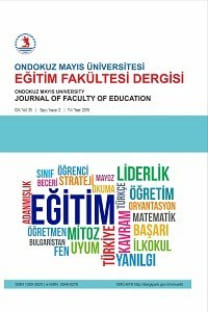Human Relations Training and Pupil Control Ideology
The aim of thi researc was to explore the effect of experiential course in human relations on teachers' pupil controlideology. Both Qualitative and Quantitative methods were used to couect data from the members of the course during, the training. The quantitative approach empıpyed a traditional pre-test post-test control group resarch design, using questionnaires to provide evidence of change in scores on tests. The qualitative data was provided by interviews. This investigation was carried ' out with 85 teachers. The experimental group in this study were forty three (43) teachers. Forty two (42) teachers who were colleagues of the experimental group were used as a control group. The sample for this research were all part-time students on the M,Ed./diploma course in human relations for 1990-1992. They were all practising teachers in a 'range of different educational contexts. The research provided an evaiuation of the outcomes of the first year of the course which involved 90 hours experientialleaming. The research indicated that the course did reduce reported stress.
Anahtar Kelimeler:
-
___
- Cadavid, V. and Lunenburg, F.C. (1991). Locus of Control, Pupil Controndeol Ogy and Dlmension of Teache; Burnout. ERIC. Paper presented at the Annual Meeting ot the American Educational Research Association (Chicago, IL, April) Ed: 333560.
- Dockinq, R.A. (1985). Changing teachers pupil control ideologyand teacher anxiety. Journal of Education for Teaching, 2
- Gardiner,D. (1980). Controildeology: Implicatlon for Curriculum Change. Paper presented at the Journal of Curriculum Thearizing Conference (Ainie, VA, .october). ERIC. Ed: 267057.
- Gilbert, D. and Levinson, D. (1957). Custodialism and humanism in mental hospital strueture and in staff ideology. Quoted in D. Willower and R.G. Jones, Studying Teaching. EnglewOOdCliffs: Prentice-Hall.
- Gorton, RA. (1976). School Administration. lowa: Wm C. Berenson, D.H. (1971). The effeet of systematlc human relations training upon classroom. performance of elementary school teachers.· Journal of Research and Development in Education, 4.
- Hall, E., Woodhouse, DA, and Wooster, A.D. (1984). An evaluation of in-service courses in human relatlons, British Journal. of in-service Education, 11(2).
- Hanis, K. R; and OtherS. (1984). .Teacher Ch. aracteristics" As Re/ated to Five Dimensions of Teacher Stress, Sex and Age. Paı>er presented at the Annual Meeting of the American Educationai Research Association (68th, New Orleans, LA, April). ERIC. Ed: 246 035.
- Moraeco, J. (1981). A comprehensive appraach to human relations training for teachers. Counsellor Education and Supervlsion, 21, December.
- Moraeco, J. and. Higgins, E.B.- (1982). The effeetiveness of a group approach. Journal for Specia/isfs in Group.Work. 7(2), May.
- Willower; D.J. (1963). eamers to change in educatlonalorqarıisation .. Therapy into Practice, 2, December.
- Willower, D.J. and Jones, RG ..(1~7). comrol in an educational organization. Raths, J.R; Pancella and J.Ş.Van Ness (Eds), Studying Teaching, Englewood Cliffs: Prentice-Hall.
- Willower. D.J. , Eidell, T. and Hoy. W.K. (1973). The School and Pupil ContrOı Ideology. Pennsylvania St;:ıte Studies Monograph No:24.. Uni~ersity Park.: Pennsylvania State University.
- Willower, D.J. and Licata; J.W. (1975). Environmental stress and school strueture. Planning and Changing.
- Willower, D.J. and Jones, R(1967). When pupil becomes an institutional therne. PHI. De/faKappan, 45, November.
- ISSN: 1300-302X
- Yayın Aralığı: Yılda 2 Sayı
- Başlangıç: 1986
- Yayıncı: Ondokuz Mayıs Üniversitesi Eğitim Fakültesi
Sayıdaki Diğer Makaleler
Egzersiz Ve Sportif Aktivitenin Büyüme Ve Gelişme Üzerine Etkisi
Osman İMAMOĞLU, M.akif ZİYAGİL, Erdal ZORBA
Sakinameler Vekafzade Faizi'nin Sakinamesi
The Celtıcrenaıssance And The Abbey Theatre: A Survey
Samsunda Sanayi Faaliyetlerinin Dağılışı, Gelişme Alanları ve Başlıca Sorunları
Metin Kavramı Ve Metin Çözümlemesı Üzerine Bazı Dikkatler
1722-1776 Tarihli Ecnebi Defterine Göre Osmanu-Rus Münasebetleri
Human Relations Training and Pupil Control Ideology
İsfendiyar (KÜRE) Dağlarının Doğu Kesiminde Bitki Örtüsü İklim İlişkileri
